The Redwood County Government Center is where the governing of Redwood County, Minnesota takes place. This includes, but is not limited to setting policies, tax management, and the various county services.
We recently spoke to Peter Brown, the Human Resources Director of this Government Center to learn about the HR Tech stack he uses day-to-day. In terms of human capital, Redwood County houses the board of commissioners, the County Administrator (a position Peter describes as the “County CEO”), and various support positions.
About Peter Brown
As the HR Director, Peter is responsible for benefits management, talent acquisition, compliance, and supervision of a payroll administrator. Although this is a lot, Peter is well-versed in HR with over 25 years of solid HRM experience.
He’s been at Redwood County Government Center for 10 years, but previously worked in HR for the healthcare, retail, disposition, manufacturing, and hospitality industries. When we asked Peter about his top passion within human capital management, he said “Benefits — I like helping people choose the right benefits so that they have the things that they need in place in case something bad happens.”
As an organization, Redwood County is spread out over multiple locations. “We have a Law Enforcement Office, Courthouse, Highway Department, Probation Office. The Government Center would be our main building. We have 124 people spread out over all of those buildings and not all of them are in-office. Our Highway workers are out in the field, usually on a daily basis and our Sheriff Deputies are out protecting our County every day.”
It’s a lot to manage. Here are the tools Peter uses to get the job done:
Redwood County’s Core HR Software - HRIS and Payroll Software
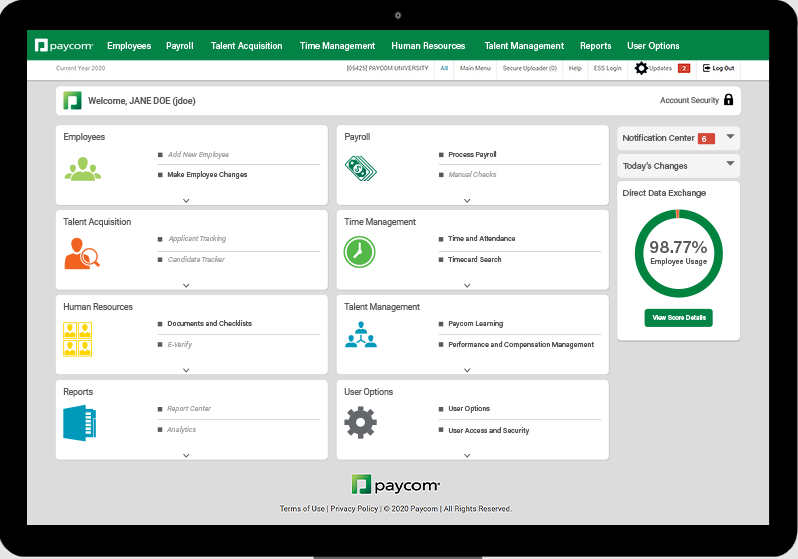
What is it called?
Paycom is an online payroll and human resource technology vendor based in Oklahoma City
According to Peter, Redwood County uses it for just about every HR function. “We use [Paycom] for benefits administration. We use it for talent acquisition. Payroll, timekeeping — we use it for everything.”
The tool also houses all their people information like demographics, benefits, and hiring data. Peter agreed this single source of truth is far more user-friendly and efficient compared to various tools with singular functions. “That’s where we used to be,” he noted. “I didn’t like it. None of them worked well together.”
How long have you been using Paycom?
Redwood County went live with Paycom in September 2017. They moved over from CPT, a niche solution based in Minnesota that only worked with counties and tax treasurer offices in the state of Minnesota.
Although it is a slightly more expensive solution than they previously had, Paycom paid them to get out of their contracts with all the other tools, which helped a lot in the first and second years. “It’s a little bit more now than what we used to pay, but as far as I’m concerned, for everything that it does, it’s still very reasonable.”
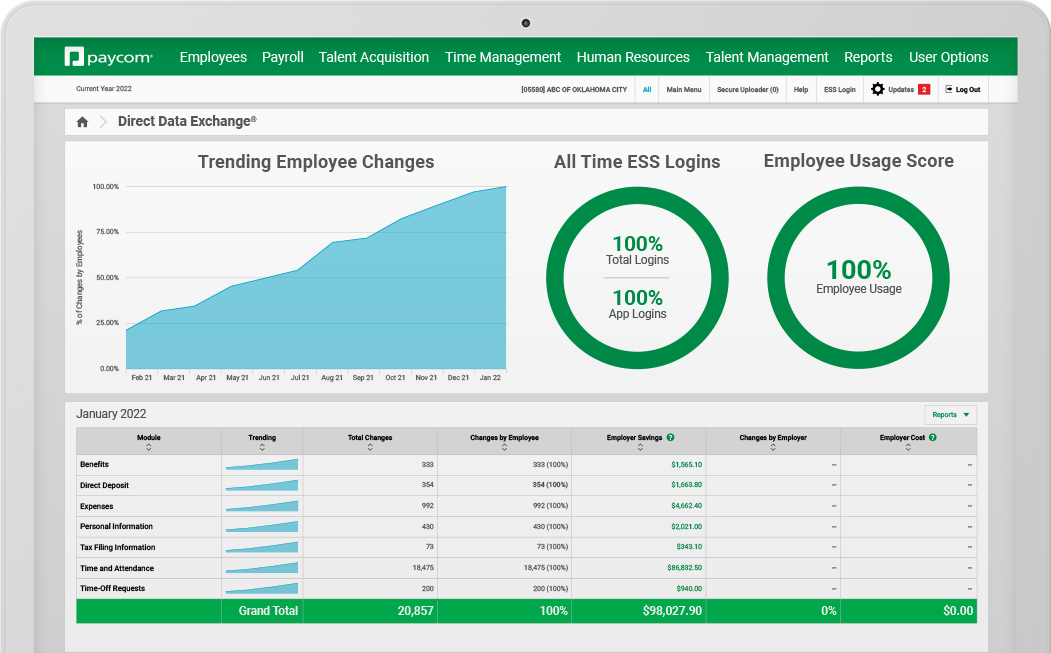
The major saving here is time. Peter doesn’t spend hours per week toggling between platforms. “[Paycom] has a little feature on their system where an accounting firm has come up with a cost per hour for a whole bunch of different processes that an HR person would do. It basically tells you what your return on investment is.” This feature tracks all the changes made by the HR department and the employees. “All the changes that the employees make (by accessing Paycom) are basically saving us money because they’re doing it, not us.”
Typical examples would be when an employee logs on to change details regarding their benefits, demographic information, direct deposit information, or tax setup. The system also takes care of tracking inward mobility and people analytics fairly well.
Did you consider any other vendors?
“I did. I looked at Kronos, I looked at ADP, and I looked at SentricHR. We knew of another County that was working with Kronos, and they were having a lot of issues which pushed that option further down the list.
Why did you choose Paycom?
“In the end, it basically came down to ADP and Paycom. ADP was quite a bit more expensive. So I told them that and they brought their rates down, but they also took away some functions I wanted, which didn’t make it a fair comparison.”
When asked if he was satisfied with his choice, Peter said he is, but there are some things that he wishes they would fix. “Being a government agency, we do a lot of dumb things, but that’s just the way we have to do stuff. [Paycom] is set up more for the private sector, so there are certain things… Like we have our pension plan calculations that took a while to figure out. About a month and a half after we went live.”
A whole system had to be built so that Redwood County personnel’s pension plan deductions could be automatically submitted to PERA (the Public Employee Retirement Association).
Another difference between government and private sector HR is in the hiring process. “We don’t allow our department heads to see any of the applications upfront. We assign questions to the application. The applicant fills them out and there are scores that are put to those questions that then add up to a total score for the applicant.”
A department head would request to meet candidates based on these scores. “If we have ten applicants and the scores range from 100 to 20, the department head can decide to interview everybody who scored above 80 (regardless of how many candidates got that score). Those are the only applications that they can see. If you give them all the applications, they’re going to pick and choose who they want to interview, and that’s not fair.” This system is specifically used to prevent bias. “Everybody should have the chance to produce an application with a high score, and only the ones that score to the level that [the department head] wants to look at should be processed further.”
Because this is not a go-to candidate pipeline for companies, Paycom doesn’t support it all the way through. “The system scores [applications], but I still have to send all the [qualifying] applications to the department head. What I would rather have the system do is, once we’ve picked a score, let me move those applications further into the hiring process. And at that point, the department heads could see them. But the system doesn’t do that. If I set a department head up in the process, they can see all the applications from the start.”
Paycom knows this feature is on Peter’s wish list, but as one of only three government counties that use Paycom, it is not a customization that is likely to happen.
What features of Paycom do you like most?
“Their benefits administration piece is very good.” Employees have full control over the benefits they enroll for, and can do the signup administration themselves. “If an employee wants to have the exact same benefits they had this year for next year, they just click a button and it rolls over their benefits, click finalize and they're done. If they want to go through the benefits and maybe make some changes, it works real slick.”
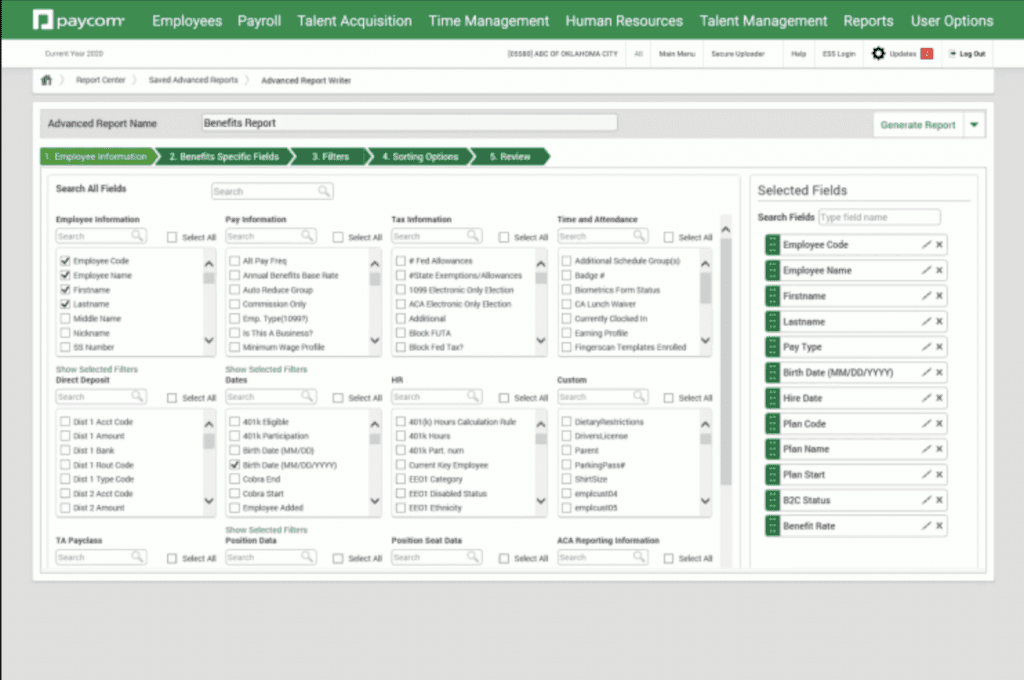
“Their talent acquisition is also really good. When a position opens up, it takes me five minutes tops to get it posted out to Indeed, our website, and an email blast.”
What's the main benefit you find in using this tool?
“The simplicity of using it. It’s very user-friendly. It does everything. The nice thing is, if you make a change somewhere in the system, like updating an employee’s address, it pulls that change through to any other place where that address is located on the system.”
Peter points out that every feature of Paycom is owned by Paycom. There are no white-label interfaces that actually lie with another vendor.
Another thing Peter highlighted was Paycom's reporting. “I can pull anything out of that system for any period of time, any data that I need, and it’s so easy.”
Is there anything you think this tool can improve on?
Paycom creates a challenge in that the payroll is limited to an odd number split that the payroll administrator at Redwood County must manually override. “If we have a benefit that’s an odd number, say it’s $39.21, the system cuts it in half to $19.61 bi-weekly, and should take only $19.60 in the second pay period. But it doesn’t do that, it takes $19.61 again. So even though it's only a penny, we can’t take that extra penny for two reasons. It’s not fair to the employee, and secondly, we get billed for that extra money. Paycom cuts a cheque for us, but the benefit provider and the treasury won’t accept it because it’s not for the exact amount.”
This discrepancy creates manual work because the payroll person has 300+ corrections to make on the second pay period each month to compensate for this. To be fair, Peter mentioned that she does a great job of getting this done quickly and accurately each time.
“The funny thing is, our old system could do this correctly, but that system was very very antiquated. This is because the system that we used was developed by a company here in Minnesota, and the guy who did the programming was able to go in and program it to work.”
Do you have any other tool in your HR Tech stack that integrates with Paycom?
“No, we don’t. Our highway department uses a cost accounting system that they want to integrate with Paycom, but we’re not at that point yet.”
How much do you pay for Paycom?
“About $45,000 per year. That’s based on a per person per pay period calculation.” The billable amount also depends on how many modules of Paycom get used. Peter uses just about every module available to him.
“However many people get paid in a pay period determines what we get charged. Plus we get charged for direct deposits, background checks, and the taxes they file for us. So every quarter we get charged a little bit more because of the cost to file our taxes drop in. They file our ACA each year and produce all of our W2’s, so it depends. Roughly it works out to about $1,500 per pay period.”
Who in your organization is responsible for this tool?
Peter is the one who manages Redwood County’s relationship with Paycom.
How would you rate this tool out of 5?
(1 = hate it, 3 = it gets the job done, 5 = I recommend it all the time)
“Can I give you two answers? If I was in the private sector, I’d give it a five. The public sector where we are, I’d probably give it a four. There are some things that need to be better, but it’s not horrible.“
To your knowledge, is there a tool that is specifically designed for the public sector?
“Have you ever heard of UKG?”
MNCCC is a computer consortium that brings solutions for the counties to use. They are currently developing a system called UKG - a collaborative creation of Ultimate and Kronos. The solution has been implemented at some test counties within Minnesota.
When we asked Peter if he’ll move over to UKG, he was reluctant. “There are a number of counties that are using it that don’t necessarily like it. So I haven’t heard enough good things about it yet to make that switch. We have a process in place with Paycom. It’s working the way we need it to. I don’t want to change anything until I know UKG has got things nailed down.”
Redwood County’s Hiring Solution
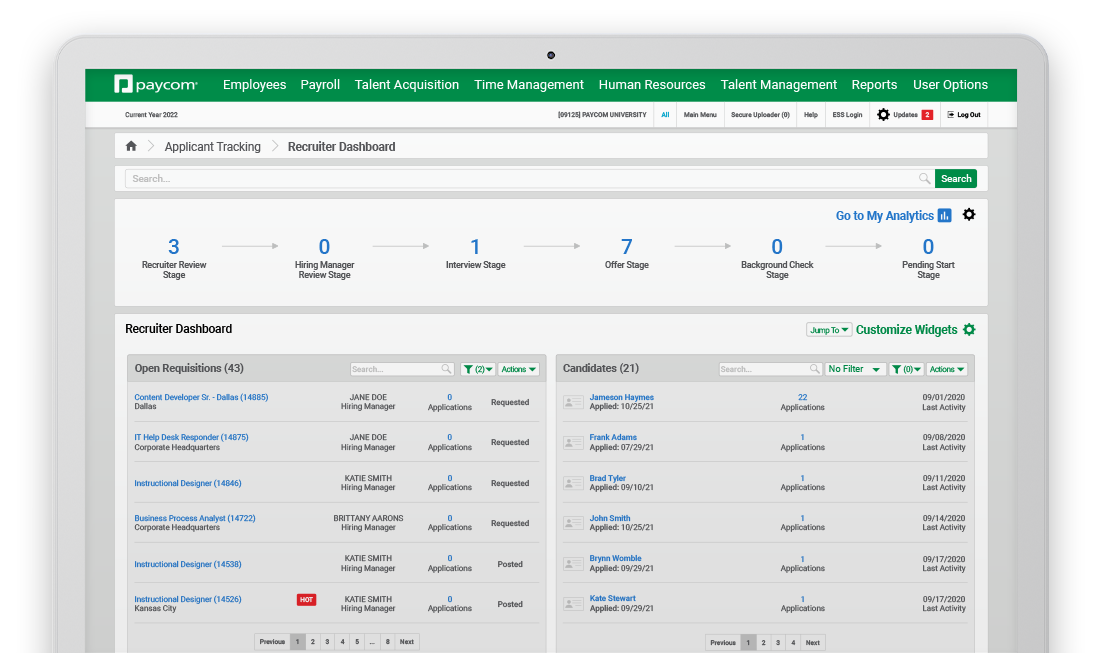
What is it called?
Paycom takes care of Redwood County’s applicant tracking and hiring too.
“When we do our interviews, and a person is chosen, I click a button and [Paycom] sends them an offer letter. If they accept that offer, I click a button and it runs a background check for them. If everything is set and we’re ready to put them in the system, I tell the system to add the person. They then go into a queue where they are sent a checklist of onboarding information, like their I9 and their W4, emergency contacts, and direct deposit information, which comes back to me, and I hit complete to add them. It’s just slick. It works really well.”
The automated workflow extends to the IT department at Redwood County who get notified by Paycom that a new hire is starting. This ensures the new hire has everything ready by their first day, including an email account, access logins, etc.
Paycom is also the tool Peter uses to schedule interviews and communicate with candidates, so it doubles up as their applicant tracking system. Being an in-person organization, Redwood County rarely does video interviews. The odd times they do hire from out of state, they do a first interview over Zoom.
Do you use any other form of automation for candidate communication?
“Paycom has a feature called AskHere. If someone has a question about their benefits, for example, there are a bunch of preloaded FAQs and answers there. But if they don’t find an answer, they can ask a question and it comes to me or our payroll person, or a County Administrator, depending on what they need to know. You set up who’s going to answer questions about which category.”
Redwood County’s Sourcing Solutions
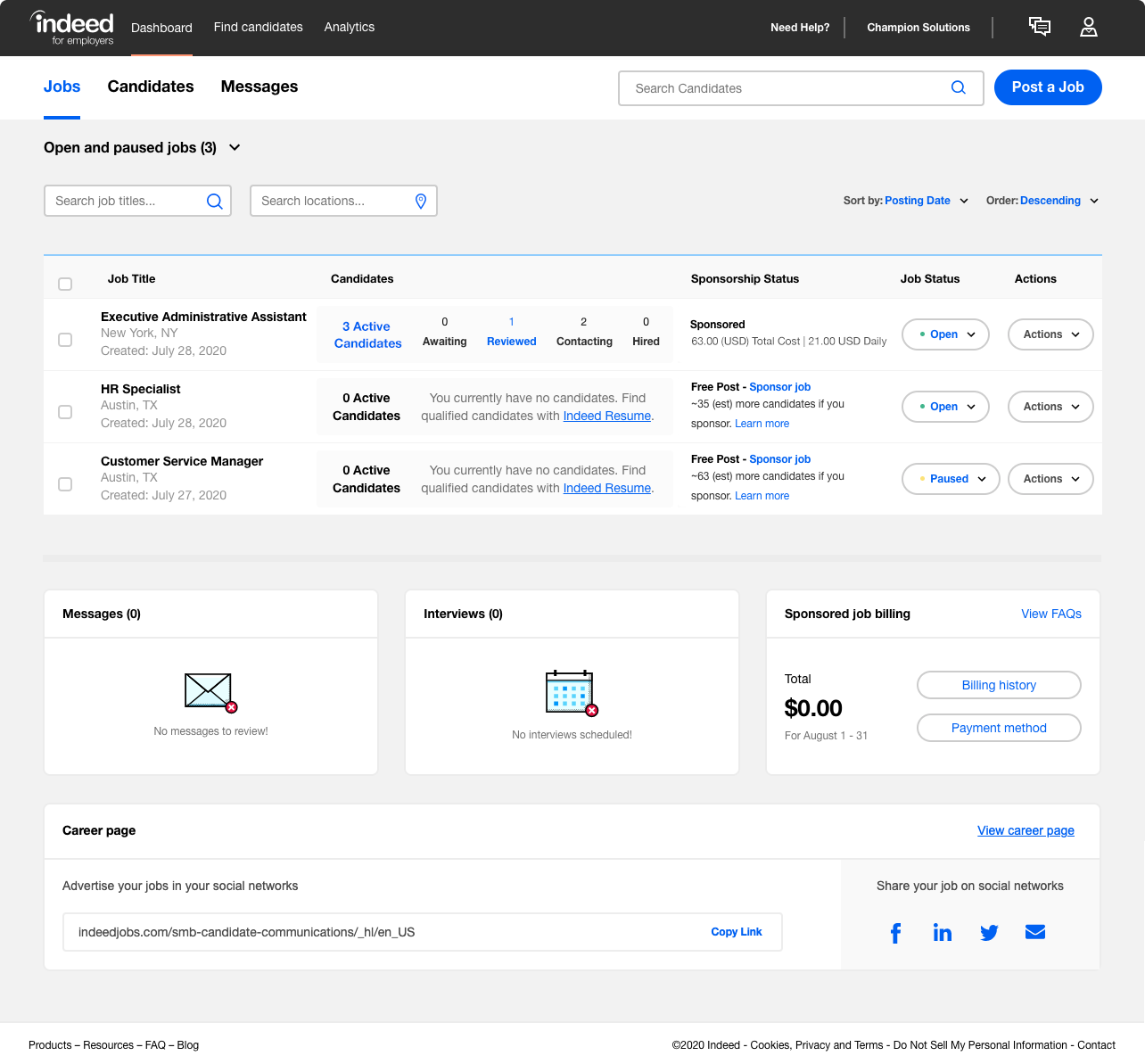
What is it called?
“I have a representative at Indeed. Whenever I’ve posted a position I just email them and tell them how much money to assign to that position. We have money on account there. Obviously, the more money I assign to a position, the further up the list it will be on Indeed. If someone clicks on the ad, it takes them to the listing on our website and they apply there. It’s a site that is created for us by Paycom.”
In order to apply, the applicant must first set up an account with Paycom. They can also opt to get notification of future job opportunities through Paycom when they get posted to the County website. “Also, on our County website they can sign up for various newsletters, as well as posted job openings. They would receive news of those job openings via MailChimp any time we do an email blast.”
Peter also posts to Facebook and to LinkedIn when he’s filling a more professional position. In both cases, the ad reverts to Redwood County’s career site.
Do you do any form of candidate assessment?
“I’m looking into that right now. I’m looking at a company called Zero Risk HR. They have an emotional intelligence assessment. They have something like 7,000 different positions that they have benchmarks for to see if a candidate is a good fit or not.”
The only other assessment Redwood County does is a written test to confirm candidates for property appraiser positions are good at math.
How do background checks work with Paycom?
Paycom used to integrate with a company called HireRight, but then they decided to bring it in-house. “I get a very nice detailed report. It does it all,” Peter notes.
Redwood County’s Performance Management Solution
What is it called?
Paycom has a performance management module that Peter is building out, but it is not implemented at Redwood County yet.
Do you use a time-tracking solution?
“People enter their hours worked in Paycom.” Salary employees only log paid vacation or sick leave, but hourly workers enter their hours worked for the day.
Paycom also offers the functionality to run a geo-specific time clock. This is ideal for the County’s highway shops where employees are working in fairly isolated locations. They can only clock in once they are actually on site. “If they punch it at home, it won’t work. We’re not using that yet, but we’ve looked at it.”
Redwood County’s Employee Wellness Solutions
Do you have a program dedicated to the financial wellness of employees?
“Paycom gives employees a breakdown for financial planning. It’s a little report that they can look at. And we have deferred compensation before or after tax that they can choose as a benefit.”
Do you have a health assistance provider?
Redwood County uses First Stop Health, a virtual medical company they signed up for a year ago. The provider also has a mental health service where employees can express a need to talk to a professional. “If they have an ailment they can call a doctor. If they need to talk, somebody gets lined up and calls them back right away. They call them back within five minutes usually.”
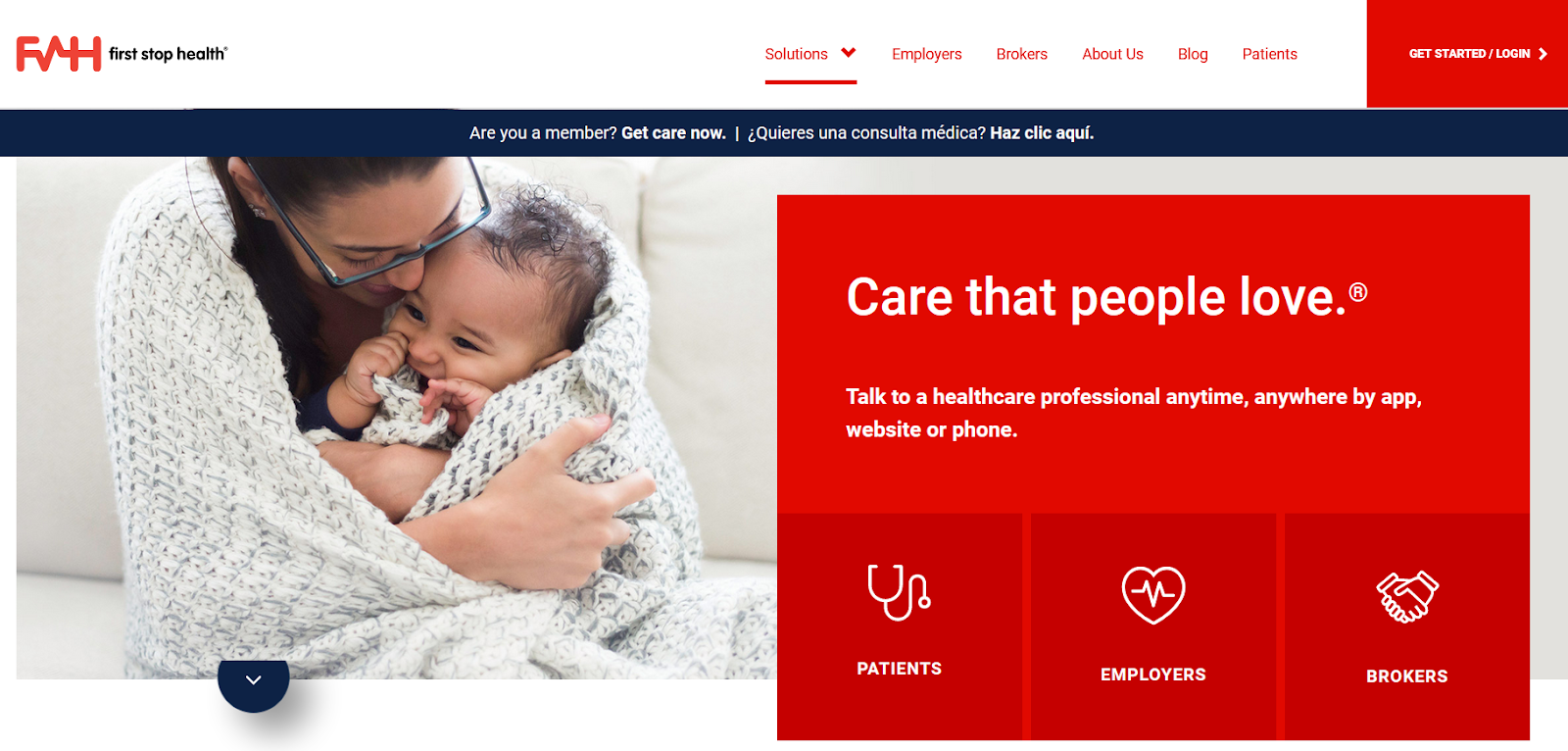
Both services are accessible via an app employees have on their phones, making it easy for them to use. “It doesn’t matter what state you’re in. If you’re traveling outside of Minnesota and you use this feature, you’ll be put in contact with a doctor who’s licensed to practice in the state that you’re in. If I need a prescription, they’ll locate the closest place where I can get my prescription and arrange for me to pick it up.”
Peter noted how well this works out for employees cost-wise. “We used to have some solutions set up through our health insurance company, MD Live was one of them. But those services cost money. If I called there would be a $45 co-pay. With First Stop Health, employees don’t pay anything.”
How much do you pay for First Stop Health?
“We pay about $980 per month. That covers the mental health side and the medical side for everybody on our health plan - all 124 people. It comes to about $11,000 per year. And the thing is, it saves us on our health plan as well. If I get sick and I would normally go to urgent care, that’s going to be $150 towards the cost of our health plan. We’re self-funded with our health plan. If I go through First Stop Health, that $150 is paid through our subscription that we have with them.”
Is there anything you think this tool can improve on?
“Oh man. No, I think it’s a great product. They send out emails to all of our employees every week to remind them of the services they offer.” Peter also noted that the First Stop Health app is extremely easy to use.
And the employees love it too. “I get a monthly utilization report, so I can see it gets used. It shows how many people contacted them and where they were calling from. I don’t know who obviously, but it shows the return on investment for us. So far it’s been unbelievable.”
If employees choose to have their families and dependents on the plan, they get full access to the services at no extra charge.
What features of First Stop Health do you like most?
Peter explained that the vendor guarantees a return on investment. “If we don’t get at least a 30% return on investment the month is free. So far, that hasn’t happened.”
They also have a feature called the Virtual Primary Care Provider. If an employee doesn’t have a doctor they normally go see, like for an annual exam, they can use First Stop Health for that type of care and get referred to a clinic for any in-person test. Redwood County doesn’t make use of this feature, but it is something they have considered.
How would you rate this tool out of 5?
(1 = hate it, 3 = it gets the job done, 5 = I recommend it all the time)
“It’s a five!”
Do you have an employee assistance program (EAP)?
“Through our insurance company that handles our workers' compensation, we get access to an EAP called Sand Creek. There’s a number that [employees] can call. Everything is confidential and it’s free to them.”

The Future of Redwood County's HR Tech
If you could rebuild your HR Tech stack from scratch today, what would be different?
“Geez I don’t know. I think at this point I would choose Paycom again.”
Which tools will you need to replace in your next phase of organizational growth?
Peter’s ultimate concern is for the County tax payers’ money. “When you’re in a setting like this, everything is about cutting costs. Basically bringing in systems that can make things easier and processes simpler is the thing. Just fine tuning everything that we’re currently doing and bringing in systems that can make things easier where you can get a return on that investment, that would be great. Whatever makes it easier for everybody.”
Found this HR Tech stack interesting? So is yours!
We’re building a library of HR Tech stacks to increase awareness of how TA and PeopleOps tools work, integrate, and add value in real organizations.
To share your organization’s HR Tech stack, get in touch with our content team at content@selectsoftwarereviews.com.




















